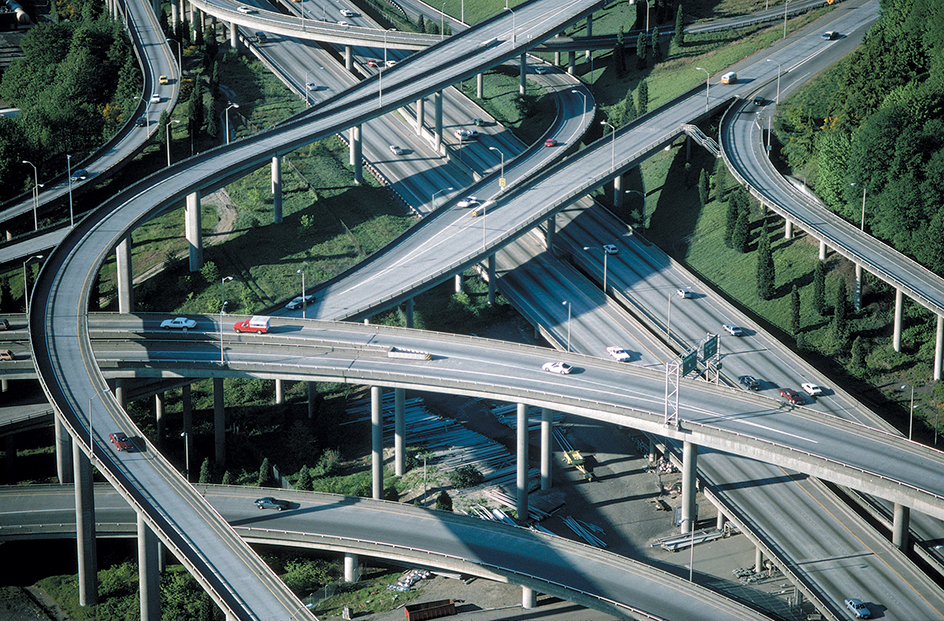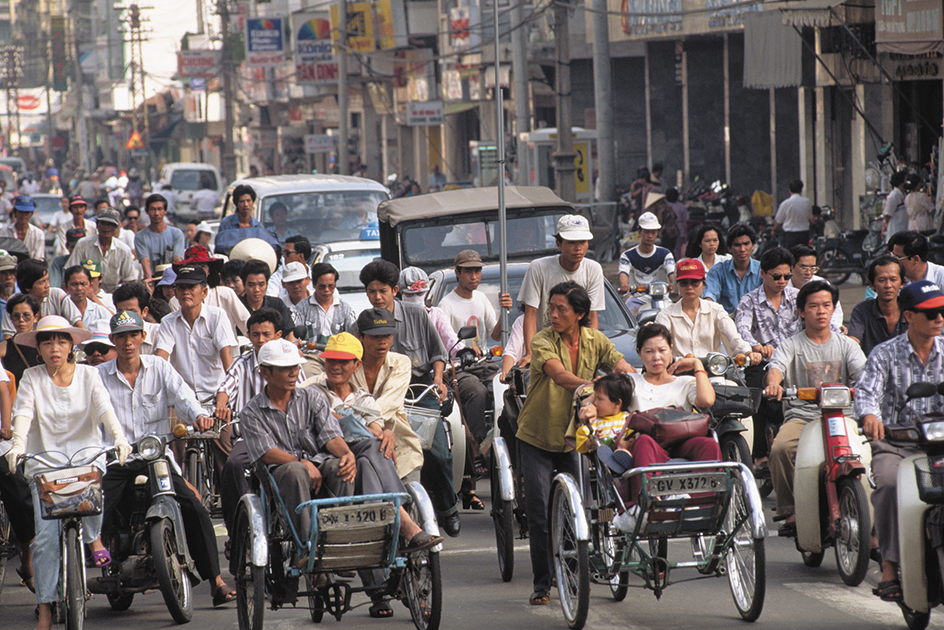Traffic is the movement of people and goods from one place to another. This article deals with traffic on streets and highways. For a discussion of other kinds of traffic, see Transportation with its list of Related articles.

Traffic problems
The millions of automobiles in the world cause many traffic problems. Automobiles often jam city streets in the morning and evening rush hours. On holidays and weekends, many highways become excessively crowded, causing inconvenience and reducing safety. Through traffic overburdens the main streets of many small towns, making it difficult for local people to get to the stores. It is hard to find a parking place in the business sections of cities and towns.
Communities try to ease traffic problems in many ways. Many have built freeways and expressways to relieve heavy traffic on streets, roads, and highways. Freeways and expressways achieve a smoother traffic flow by controlling where vehicles can enter and leave. Traffic engineers and highway crews constantly maintain and improve these roadways to relieve crowded conditions.
Bypasses take motorists around, rather than through, towns and cities. They ease traffic congestion in towns and the business districts of cities, thus helping local business. In some cities, convenient, comfortable, and inexpensive mass transit systems also help relieve congestion. Better provision for truck loading and unloading at stores, office buildings, and factories eases the problem of truck interference on streets. It also reduces the cost of delivery and distribution of goods.

Many cities and towns prohibit parking at the curb to make additional street space available for traffic. Many places provide parking for large numbers of cars in off-street parking areas.
Traffic engineers achieve more efficient use of existing streets is obtained in several ways. These measures include: (1) creating one-way streets; (2) changing traffic lanes to one-way operation during hours of heavy traffic; (3) installing modern coordinated traffic-signal systems, turn controls, and pedestrian controls; and (4) developing through-street systems to move traffic faster.
Traffic control
Every year, traffic accidents kill tens of thousands of people and injure several million. Drivers and pedestrians can reduce the number of traffic accidents, injuries, and deaths by watching and obeying traffic control signs, signals, and pavement markings. Special control devices, such as electric signs that tell when to cross streets and highways, aid pedestrians. These signs operate with vehicle traffic signals.
Signals, signs, and markings.
There is no clear record of who invented or first used traffic control devices. Traffic signs date back to the early Roman roads. Railroads used traffic control signals before streets did.
The first electric street signals on record were installed in Cleveland in 1914. It is generally agreed that three-color, four-way traffic lights first appeared in Detroit in the early 1920’s. The Wayne County (Michigan) Road Commission developed the use of a white center line for separating driving lanes on highways.
Traffic controls are increasingly necessary for regulating, warning, and guiding motor vehicle and pedestrian traffic. The law requires signs to indicate how certain traffic regulations apply. Adequate use of warning signs, and well-designed and well-located route markings have great value, too, in helping the flow of traffic.
Pavement and curb markings and traffic islands, when properly designed and located, also help guide traffic. Traffic lanes, pedestrian crosswalks, turn markings, and warning signs frequently are painted or otherwise marked.
Modern traffic lights are made so that they can be set to change when traffic demands it. In most places, the changes are automatic every so many seconds or minutes. Where there are different amounts of traffic on intersecting highways and streets, the light can be set so that it will remain green longer for the highway or street with the most traffic. Some traffic lights also are arranged so that the traffic itself will cause them to change. When vehicles pass over detectors in the roadway, the light changes to let them go through the intersection. Most roadway detectors are electrified wire loops that can sense the presence of metal. Traffic signals can also be set to respond to switches pushed by pedestrians, and to other switches activated by trains or emergency vehicles, such as ambulances and fire trucks.
Sign manufacturers cover many warning and guide signs with luminous paint, or glass or metal beads or buttons, which reflect beams from headlights. The reflections make the signs easier to see at night. Sometimes, various types of reflector buttons or white material are embedded in the surface of the street or highway.
Control devices must be in the right places or they can cause delay and congestion, and lead persons to disregard them. Good control devices must be based on sound engineering principles. Studies of types and flow of traffic, accidents, speeds, delays, and physical conditions show the exact nature of a traffic difficulty and indicate the methods of control that are needed.
Traffic regulations
are the rules of the road governing the actions of pedestrians and drivers on public roads and streets. Regulations should be uniform, so that drivers everywhere will know exactly what actions to take under like conditions.
Parking meters
were first used in Oklahoma City, Oklahoma, in 1935. They were originally located only at the curb. but today, many parking lots also have parking meters. Parking meters are used to restrict the length of time vehicles are allowed to park, or to collect parking fees, or both. The meters may operate mechanically or electronically.
Traffic police
enforce traffic-control measures and regulations, and control traffic emergencies. Development of street and highway facilities and traffic-control plans are the responsibilities of highway or traffic engineers.
